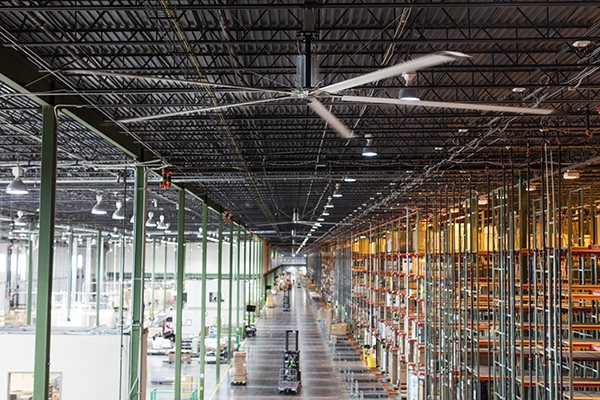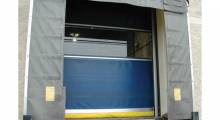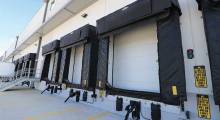When evaluating the need for industrial HVLS (high volume low speed) fans, every application has its set of challenges.
For example, the interior of every structure has a unique story to tell. Some require constant cooling for product protection while others in cold climates require increased air circulation for even heat distribution.
Other interior spaces stay dry year ‘round, while others have floors that notoriously sweat because of high humidity or become wet from outdoor elements getting inside. Efficiently moving a large volume of air at a low speed is an industrial HVLS fan’s very reason for being.
There’s more to such fans than many people realize, and you owe it to yourself to take the time to work with your fan provider to properly plan their placement. In the end, achieving your desired outcomes ensures that you’ll gain the maximum benefit out of your fans investment.
HVLS fan placement on a large scale done right
But first, consider Nebraska Furniture Mart (NFM)-Texas near Dallas, a textbook example of an industrial HVLS fan installation done right. Working in conjunction with powerful rooftop-mounted exhaust fans on the store’s 1.3 million-square-foot warehouse/distribution center (DC), 98 industrial HVLS Entrematic Fans strategically help to circulate cooler air that sinks to floor level. Together, they keep employees comfortable and ensure higher air quality throughout the entire facility.
NFM-Texas and its mechanical engineering firm worked closely with Entrematic Fans to map out an optimal air flow pattern. The largest industrial fans move and circulate cooler air in the more expansive areas, while the smaller fans are located above the DC’s mezzanine and in shop and product preparation areas. Two dozen 24-foot industrial fans, positioned above drive aisles – or “autobahns” – help to move air both in the autobahns as well as down warehouse racking aisles.
7 important fan planning factors
NFM-Texas was obviously a very large undertaking that took a lot of careful planning to ensure a successful outcome. But regardless of your fan project’s size and scope, here are seven important HVLS fan planning factors you need to address from the start:
Establish your goals early to ensure the right results later. Determine what you realistically expect to achieve. Ask yourself what critical goals you need to meet once your fans are installed and operating. You never want to find out after the fact that your fans are not providing the results you had anticipated.
General rules do exist (but there are plenty of exceptions). Always remember that every site application is different. Pay special attention to obstructions that might affect airflow, such as racking, HVAC ductwork or machinery. Obstructions all have an impact on both fan size and the quantity needed.
Hot vs. cold: critical considerations between summer cooling and winter destratification. Plan accordingly based on your local climate and your facility’s layout. Proper fan placement can have a tremendous impact on cooling comfort when your HVAC system is working hard during hot weather, and during cold weather, fans can recirculate warm air that becomes trapped near the ceiling.
Don’t slip up on wet floors, summer comfort or product protection. Properly plan for moisture issues as well as the hottest months. Correctly placed and sized HVLS fans are the perfect solution for keeping otherwise wet floors dry and safe, humidity levels in check and preventing sensitive and perishable products from spoiling.
More questions are always better than not enough questions. A thorough site analysis is one of the keys to success. Take the time to evaluate how genuinely interested your fan provider is about your specific application. Are they recommending certain quantity of fans with proper justification? Do they clearly understanding your goals and making sound recommendations based on a thorough analysis of your environment?
Typical industrial spacing is not always so “typical.” Fact is, every facility has very different needs. Whether your facility needs to replace improperly spaced fans from another provider or needs to embark on a new industrial HVLS fans project, a provider with an engineering perspective about proper fan spacing will be a huge benefit in the long run.
- Juggling multiple facility issues to achieve multiple solutions. A one-size-fits-all approach is never your best option. While every facility has unique airflow challenges – such as stagnant air, wet floors or an ineffective HVAC system – structures of all shapes and sizes often face a variety of simultaneous air movement issues that require different solutions. Ask your fan provider how best to handle such solutions independently.
Wrong choices can cost money
It doesn’t pay to run the risk of making an unsound decision – or worse yet – a series of potentially expensive mistakes about your industrial HVLS fan investment. Making the wrong choice could end up costing your company or business thousands of dollars to correct if your fans don’t end up providing the results you expected throughout your facility.
To learn more about Entrematic’s industrial HVLS fans, as well as which approaches and solutions are best suited for your application, visit us online at entrematicfans.com or place a direct call to 866-696-2464.
Article topics








